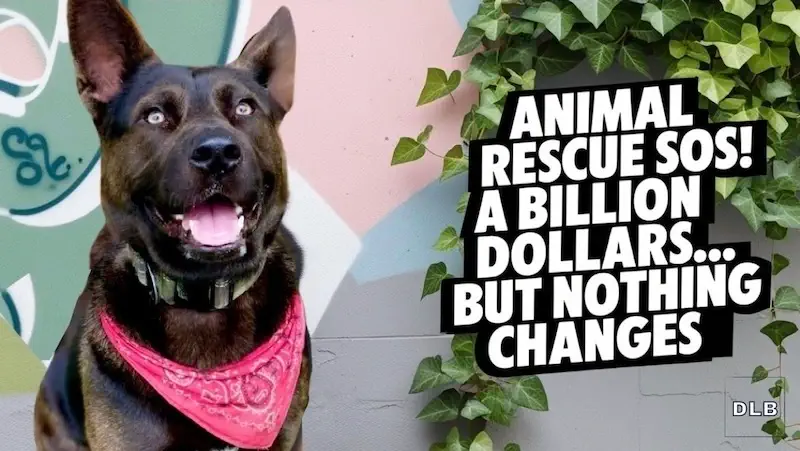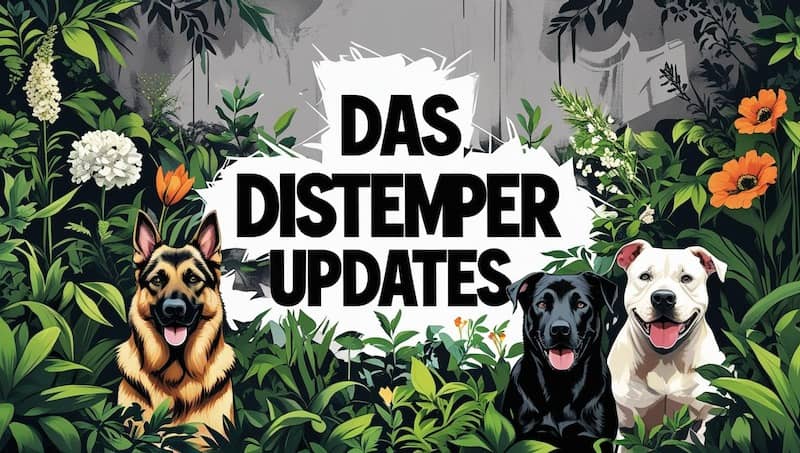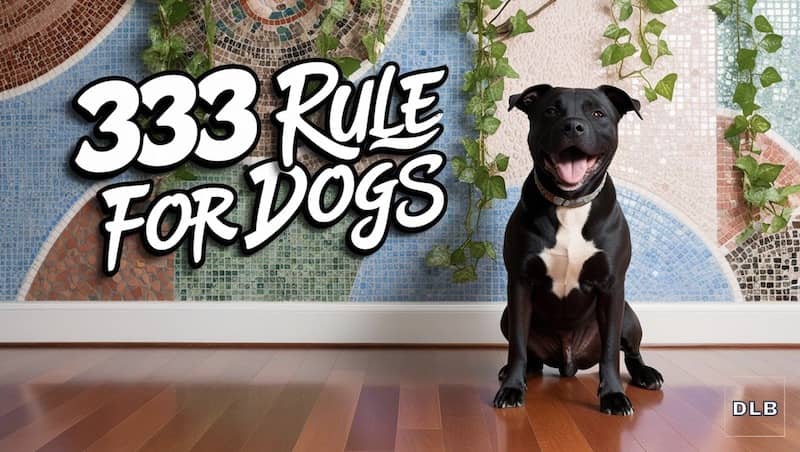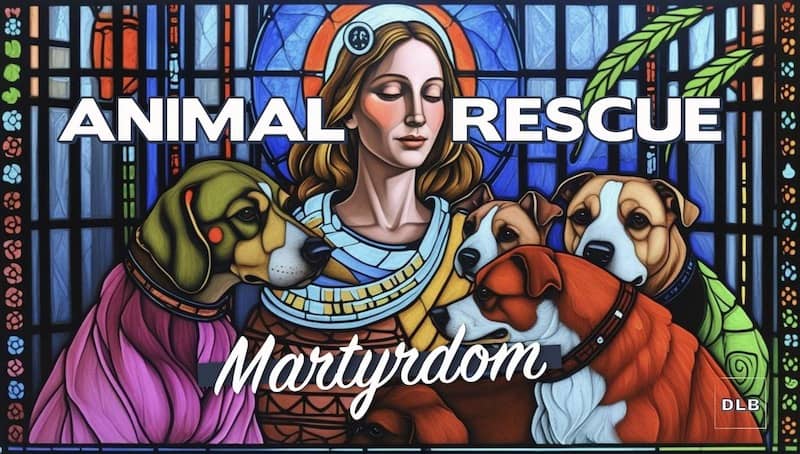Animal Rescue SOS: A Billion Dollars... But Nothing Changes

Note: This article was originally published 4/16/2024 and was most recently updated at the current publication date.
We Are In A Dog Overpopulation Crisis
We Are In A Dog Overpopulation Crisis...In the Southern USA, Nationally, Globally.
We cannot adopt, rescue, or foster our way out of it.
Yet those three spaces are where almost all resources (billions of dollars, many humans, and so much time) are concentrated in response to the dog overpopulation crisis.
The United States Euthanizes Approximately 1 million Dogs and Cats, Every Year.
Reproduction is the core issue behind dog overpopulation and the resulting euthanasia and there is not significant effort in this sector with a comprehensive, long term strategy.
We are pouring billions of dollars a year at the end of the line but there is no hope of ever quelling or ending the overpopulation crisis without adding or shifting effort and resources to the head of the problem.

What Is The Core Issue Behind The Need to Euthanize Healthy, Adoptable Dogs For Space?
Dog* Overpopulation. Which is caused by dogs breeding i.e. reproduction.
The core issue of dog reproduction is not being addressed in a focused, comprehensive manner
There are bits of work here and there to shut down puppy mills, groups which work hard to enact breeding laws (which are frequently unenforced), scattered spay & neuter efforts, and endless large and micro rescues rehoming (and sometimes rehabbing, prior) the dogs at the end of the line, one-by-one.
What is Dog Overpopulation?
DOG OVERPOPULATION is more dogs than there are homes interested in caring for those dogs, for the dog's entire life.
How Do We Curb The Population of Unwanted Dogs?
There is only one answer: Reduce BREEDING, i.e. REPRODUCTION. Whether breeding is happening purposefully to sell dogs or reproduction happens because of the lack of Spay & Neuter.
We must curb reproduction of dogs. Specifically, in the Southern USA, these breeds need the most attention:
- PITTIE / BULLY breeds
- SHEPHERD breeds
- HUSKIES
- GREAT PYRENEES
- CATTLE DOGS
- Honorable mention to: aussies, 'oodles, and pointers
What do most of these dogs have in common? They are working breeds. These dogs are smart - ample exercise is required to keep them sane and healthy. They need things to do. They are not "sit at home all day" or "chill on a public restaurant patio during happy hour" types of dogs.
What Will Curb Dog Breeding i.e. Dog Reproduction?
- ACCESS easy, plentiful, free spay & neuter
- HIGH ENTRY POINT expensive breeding licenses, annual paperwork and welfare checks
- LAW ENFORCEMENT of spay & neuter, breeding laws and requirements
- EDUCATION saturate communication spaces
- COMMUNITY AWARENESS
- REPUTATION the right thing to do, the "in" thing to do, what peers and role models encourage and showcase
- CULTURAL ACCEPTANCE
- COMMUNITY EMBRACEMENT
- SMART, FOCUSED PROJECTS such as Flag The Breeders
Why Do Only Certain Animal Shelters Euthanize Dogs?
No one wants to euthanize dogs.
"No Kill" rescues have the luxury to close intake while "Kill" Municipal shelters don't and are faced with the horrible scenario of constant dog intake with nowhere for the dogs to go. Learn The Difference Between "Kill vs No Kill" Here
Why Isn't An Established, Well-Funded Entity Working on The Core Problem of Dog Reproduction?
We are not sure of the answer to this but do notice that promotion of helping the most tragic, broken animals from the most deplorable conditions is what seems to generate attention and donations. This may partly explain why large organizations are focused at the end of the line - helping dogs one-by-one. And, of course, those animals DO need our help.
However, to help MILLIONS of dogs - focus, efforts, and resources must shift.
Current Distribution of Resources in Animal Advocacy and Welfare
In our research here at DLB, we wanted to look at what some notable animal welfare orgs in the country and region have going on to see what resources are out there and what the core focus is at well-funded organizations.
There is nearly a billion dollars outlined below and the people and time in association are almost exclusively focused at the end of the line.
In other words - the resources to help homeless animals is almost entirely stacked at one end of the spectrum.
The below Notable United States and Texas Animal Rescue and Welfare Organizations listing is not meant as judgement or expectation - all of the below organizations have a specific focus and function, only one of which is specifically curbing dog overpopulation.
The list below includes some of the obvious organizations and facilities to review in order for us to catch a bird's eye view of who is working on what in the animal rescue and welfare space.
NOTE: Expense numbers below are rounded, for ease of scannability. All non-profit organization's expenses below are self-reported; links jump to corresponding report.
AMERICAN SOCIETY FOR THE PREVENTION OF CRUELTY TO ANIMALS (ASPCA)
$355,500,000 2023 ASPCA Annual Budget / Operating Expenses
$340,400,000 2022 ASPCA Annual Budget / Operating Expenses
The ASPCA is focused on cruelty to all animals. They are active in responding to natural disasters that put animals at risk and have a strong presence in education for veterinarians and other animal care professionals.
The ASPCA's publicly listed mission is to: 1) keep animals in their homes by supporting others who provide: pet food banks, community vaccination clinics, spay and neuter services, collars, tags and flea treatments 2) pet helplines 3) support others who provide temporary housing for pets whose families are in crisis due to homelessness or domestic violence.
The ASPCA acknowledges that unchecked stray growth is happening in areas without accessibility to low cost spay and neuter readily available, but they have no plans or programs in place to correct this issue.
BEST FRIENDS ANIMAL SOCIETY (BFAS)
$315,000,000 2024 Best Friends Animal Society Annual Budget / Operating Expenses
$334,300,000 2023 Best Friends Animal Society Annual Budget / Operating Expenses
$221,000,000 2022 Best Friends Animal Society Annual Budget / Operating Expenses
The Best Friends Animal Society began as The Process Church of the Final Judgement, also known as The Process, which already had a non-profit status, and in 1991 the founders changed their focus and name to Best Friends Animal Society.
Their current, key promotion is taking the USA to “No Kill” by 2025. In support of this goal, BFAS has a large amount of network partners (4000+) with whom they conduct data studies to share data, methods, and programs. Their programs and strategies are used in shelters and rescue groups, nationwide.
BFAS is also involved in Advocacy and Legislative Work such as puppy mills, outdoor cats, and breed-specific legislation.
Operating three brick & mortar sanctuaries, their Utah Sanctuary is self-reported as the largest in the country. BFAS also provides grants to animal advocacy non-profits.
HUMANE SOCIETY OF THE UNITED STATES (HSUS)
$214,800,000 2023 Humane Society Of The United States Annual Budget / Operating Expenses
$174,000,000 2022 Humane Society Of The United States Annual Budget / Operating Expenses
The HSUS (Humane Society of the United States) was founded in 1954 with the mission to specifically prevent cruelty to animals in laboratories, slaughter houses, and puppy mills.
HSUS has a strong presence in the legislative arena for making laws that prevent pain, fear, and abuse of all animals.
In 2021 The Doris Day Animal League (DDAL) merged with the Human Society Legislative Fund. Doris started World Spay Day in 1995 with DDAL, which is held on the last Tuesday of February each year and its main focus is to promote spay and neuter to help the problem of homeless pets. Between 2008 and 2018 they have given HSUS $760,000 to have 14,873 dogs, cats, and rabbits in 39 States and D.C. spayed/neutered by event organizers. The DDAL continues to provide grants, through HSUS, to organizations supporting pets and the people who love them. They focus on spay/neuter, veterinary expenses, and food pantries.
HSUS operates a large Sanctuary, Black Beauty Ranch, in Texas which is home to rescued domestic and exotic animals. The organization's "Wildlife Land Trust" has participated in the protection of wildlife habitat in 39 states and nine foreign countries creating safe havens for wild animals. HSUS does not actively run any shelters but 1% of their budget goes to support local shelters.
PETSMART CHARITIES
The Pet Store's Non-Profit Organization
$81,000,000 2023 PetSmart Charities Annual Budget / Operating Expenses
$88,000,000 2022 PetSmart Charities Annual Budget / Operating Expenses
Founded in 1994, PetSmart Charities' mission is to make the world a better place for pets by investing in community partners that advocate and care for the wellbeing of pets and those who love them. They take any monies collected and distribute them via grants to non-profits that they have partnered with to rehome animals and to provide wellness and care for animals.
PETCO LOVE
The Pet Store's Non-Profit Organization
$40,000,000 2023 Petco Love Annual Budget / Operating Expenses
$40,000,000 2022 Petco Love Annual Budget / Operating Expenses
Founded in 1999, Petco Love partners with other organizations to provide services under 3 subgroups.
- LOVE ADOPT rehoming of animals looking for their new home
- LOVE CARE facilitates access to free or low-cost wellness, spay and neuter services, and cancer care (to name a few)
- LOVE LOST a website run by Petco Love to reunite lost pets with their owners (use of AI for matching!)
Petco Love also takes any monies collected and distributes through grants to non-profits that they have partnered with.
THE ASHER HOUSE
$1,340,000 2022 The Asher House Annual Budget
$1,340,000 2019 The Asher House Annual Budget (yes, same amount)
Arguably, the most "social media famous" animal rescue. On our Dallas Love Bugs EU Risk dog posts, especially on Facebook, there are always many people who comment, "just call Lee Asher."
Of course, the general public does not understand the scope of the problem VS how many dogs The Asher House is able to help. But we wanted to list this rescue, here, to help educate the public in a big picture way. Lee and his team does great work, sets a terrific example, and educates about the homeless dog overpopulation crisis.
But, it is important to understand that even if Lee was able to help 1000 dogs year, the USA euthanizes about one million dogs and cats every year.
Non-profit organizations are required by law to make their financial statements available to the general public. It was very challenging for us to locate any financial statements or reports for The Asher House.
What is linked above is all we could track down (DLB aims to update the reported budgets and links in this article at the end of every calendar year which is generally when the non-profits have posts their prior year's financial information).
SOCIETY FOR THE PREVENTION OF CRUELTY TO ANIMALS of TEXAS (SPCATX)
Serving North Texas
$22,000,000 2023 SPCA of North Texas Annual Budget
$24,000,000 2022 SPCA of North Texas Annual Budget
SPCATX's mission statement is to provide every animal exceptional care and a loving home with a stated focus to keep pets off the streets, healthy, and safe in loving homes.
All adopted pets are spayed/neutered before going home and SPCATX collaborates with area shelters and rescues on spay & neuter events.
SPCATX runs two clinics which provide vet care services and spay & neuter with a focus on serving pet owners who otherwise may not be able to provide high-quality care for their pets.
The SPCA of Texas maintains an Animal Cruelty Investigations (ACI) Unit with three full-time humane investigators. The non-profit also has an Animal Crisis Response Team for disaster response.
HOUSTON SOCIETY FOR THE PREVENTION OF CRUELTY TO ANIMALS (HSPCA)
$17,000,000 2022 Houston SPCA Annual Budget
$16,000,000 2022 Houston SPCA Annual Budget
HSPCA helps with cruelty cases and in natural disasters along with wildlife, farm animals, and household pets.
Offering school age programs, HSPCA runs a summer school for kids interested in learning about animal care. The organization has connections to veterinary education including the Texas A&M veterinary school.
HSPCA runs a recently-opened wellness clinic which offers vaccines and treatments for common maladies such as heartworms, respiratory infections, diarrhea, and ear infections. Community programs include a food pantry and their program "PetSafe."
PetSafe supports domestic violence victim's pet needs such as temporary animal boarding, veterinary care, and spaying/neutering. HSPCA partners with women's and family shelters in the area so that furry family members are not lost to victims' abusers.
HSPCA readily states that there is a need to lower the number of dogs and cats and note that spaying/neutering animals is the solution. They spay/neuter all pets who are adopted through their organization.
AUSTIN PETS ALIVE (APA)
$17,000,000 2022 Austin Pets Alive Annual Budget
APA's stated vision is that every shelter animal in Central Texas and beyond gets a true chance at the life they deserve.
APA has succeeded as a support system to the Austin Municipal Shelter AAC (Austin Animal Control) pulling at least 12% of annual intakes which has supported AAC to meet the no-kill threshold (90% live release rate) since 2015.
APA's PASS (Positive Alternatives to Shelter Surrender) program supports families at risk of having to surrender their pet because of hardship or financial challenges. PASS is a flexible-support program which may assist in ways such as covering an animal's medical treatment, providing temporary boarding for a pet(s), or covering a pet deposit at a residence.
PARVO treatment is one of APA's specialties - they help local community cases as well as others from around the state (including Parvo cases from Dallas Animal Services). A new APA animal hospital is slated to open July 2024.
All APA-adopted pets are spayed/neutered before going home.
OPERATION KINDNESS (OPK)
$11,500,000 2023 Operation Kindness Annual Budget
$8,000,000 2022 Operation Kindness Annual Budget
OPK's stated mission is to to create a kinder world for pets and the people who love them by providing lifesaving care, innovative programs and community resources.
OPK is one of the few area non-profit rescues with their own brick & mortar building to shelter pets.
OPK is currently Dallas Animal Services's biggest support in number of dogs and cats tagged from DAS as well as supportive programs.
OPK's supportive programs for the municipal shelter and public at large include pet adoptions, lifesaving medical care for shelter pets, 24-hour care for neonatal kittens, affordable veterinary services for community pets, a pet food pantry, forensics for animal cruelty, interstate transport, lifesaving shelter partnerships, disaster response support, foster care for vulnerable animals and volunteer opportunities.
SPAY NEUTER NETWORK (SNN)
$4,200,000 2022 Spay Neuter Network Annual Budget
Started in 2004 - their mission is to eliminate pet overpopulation through spay/neuter while empowering communities to care responsibly for dogs and cats by offering free or low-cost spay and neuter services. Currently operating 4 clinics serving over 16 counties in Texas, the focus is on neighborhoods and communities that have little to no access to basic veterinary care in and around DFW and San Antonio. Spay Neuter Network also provides mobile services for rural communities and recently started a pet transport program to get animals to one of their clinics. SNN partnered with DAS in 2020 to provide resources to keep animals in their homes. The Spay Neuter Network Website offers an impressive list of support links from rehoming your pet, short term boarding or temporary fostering, to free or low-cost vaccines, discounts on medicine, and funding for animal healthcare.
DALLAS PETS ALIVE (DPA)
$750,000 2022 Dallas Pets Alive Annual Budget
DPA's stated mission is to promote and provide the resources, education, and programs needed to eliminate the killing of companion animals in North Texas.
DPA does not have a brick and mortar animal sheltering space but takes homeless dogs in via foster-based program. Their focus is on rescuing healthy and treatable pets at the greatest risk of EU and DPA recently assumed Dog's Matter - another non-profit which helps people seeking drug or alcohol rehabilitation treatment by finding a foster for their dog(s) and supporting those fosters while the human is in treatment.
DPA's PASS (Positive Alternatives to Shelter Surrender) program supports families at risk of having to surrender their pet because of hardship or financial challenges. PASS is a flexible-support program which may assist in ways such as covering an animal's medical treatment, providing temporary boarding for a pet(s), or covering a pet deposit at a residence.
DALLAS ANIMAL SERVICES (Dallas municipal animal shelter)
$18,000,000 2023 City Budget
$16,000,000 2022 City Budget
BARC ANIMAL SHELTER AND ADOPTIONS (Houston municipal animal shelter)
$13,300,000 2023 City Budget
$14,000,000 2022 City Budget
As with any municipal shelter in the Southern USA, these two city shelters are in daily crisis mode of population overwhelm while attempting to keep the train on the rails taking care of animals on site, responding to public animal needs throughout the city, and effecting as many positive outcomes as possible. Both DAS and BARC sterilize adopted animals before leaving the shelter's ownership for the animal's new home.
So... What Is the Solution To Getting at The Core Problem of Breeding?
We need one or multiple of:
- Dedicated Division created at one of the large, super-funded organizations
- New and Specifically-Focused Organization(s)
- Government Department / Task Force
Then a HAMMERING of the messaging, work, adjustments, and change over decades...
A multi-front campaign should run until data and scenarios have permanently shifted and we no longer have to euthanize healthy, adoptable dogs because there will be a manageable amount of dogs needing rehoming (versus the current volume of daily urgency and exhausting challenge).
SOS! WHO CAN HELP?!
P.S. the cats need us, too, but we focus on the dogs, right now, here at DLB... they present more of a public danger, they need humans a bit more to survive, and we believe once we get the ball rolling on the dogs, the same issue with the cats can snowball behind the dog movement.
_______________
We all want to help.
Efforts are scattered and unfocused.
It is exceptionally easy to manipulate people in this space and the animals pay the price.
Dallas Love Bugs is digging into the overarching practices in the Animal Rescue Space to try and figure out… with so much money, so many resources, so many people who care… why are we euthanizing a million dogs and cats a year?
Why is nothing changing? Let’s Fix It!
9 Ways Martyrdom Hurts The Cause
The Business of A Never-Ending Crisis
5 Easy Ways To Improve Animal Rescue Efforts... Right Away!
_________________
WATCH: 30-Minute INTERVIEW about this "SOS" Dallas Love Bugs article | Brit Madrid / WFAA / BZen TV
_________________
Do you have data or information which may improve this article? Please email: kisses@dallaslovebugs.com
Thanks to Renee Way, DLB Data Manager, for her assistance in research for this article.


We must alter our thinking and actions in this space. Everyone scrambles, everyone is exhausted, the numbers don't change. We must take a different approach and concentrate on the core problem to combat "for space" dog euthanasia.












